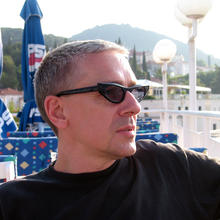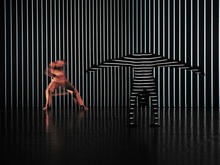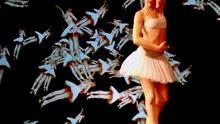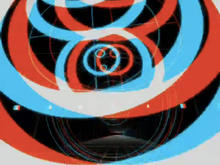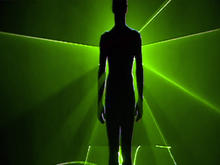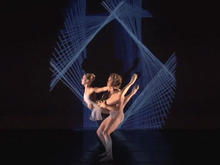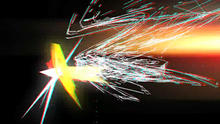Igor Stravinsky: Le Sacre du Printemps
(2006)is an interactive stereoscopic project by Klaus Obermaier and Ars Electronica Futurelab, featuring Julia Mach. Premiered by the Bruckner Orchestra Linz, Dennis Russell Davies.
Le Sacre du Printemps is an interactive stereoscopic project. Be aware that this only a 2D documentation.
The epoch prior to World War I, the time in which Igor Stravinsky composed Le Sacre du Printemps [The Rite of Spring], was characterized by an ecstatic desire to experience the intensity of life, an emotion that would later mutate into an equally euphoric enthusiasm for war. Logically Stravinsky conceived Le Sacre as an orgiastic mass ballet.
The dissolution of social structures is reflected in the dissolution of conventional developments and structures in the composition: Fragmentary, blocklike lining up of movements; abrupt shifts; polytonality and polyrhythm.
This led, together with Nijinsky's choreography, which translated the composition beat for beat with hectic and complicated movements into dance, to one of the largest premiere scandals of music history.
Now, nearly a hundred years later, the issue of the day is the authenticity of experience in the light of the ongoing virtualization of our habitats. It is the dissolution of our sensuous perception, of the space-time continuum, the fading dividing line between real and virtual, fact and fake, that takes us to the limits of our existence.
The discrepancy between subjective perception and seemingly objective perception produced by stereoscopic camera systems, whose images are filtered and manipulated by computer, constitutes the basis of my staging of Le Sacre du Printemps.
It is about the immersion of the 'chosen one' in virtuality, her fusion with music and space, as an up-to-date 'sacrifice' for uncertain future and as a metaphor for deliverance and for the anticipation of the eternal happiness, that new technologies and old religions promise us. Or at least a new dimension of perception.
In addition Le Sacre du Printemps brings up for discussion the complex relationship between music, dance and space. In conventional productions of Le Sacre one choreographs and dances to the music. In this case, though, the dynamics and structure of the music interactively transform the virtual presence of the dancer and her avatars and thus produce a sort of 'meta-choreography.'
Stereoscopic projections create an immersive environment, which permits the audience to participate substantially more closely on this communication than in traditional theatre settings.
Stereo cameras and a complex computer system transfer the dancer Julia Mach into a virtual three-dimensional space. Time layers and unusual perspectives overlay one another and multiply themselves, and enable a completely new perception of the body and its sequences of movements. Real-time generated virtual spaces communicate and interact with the dancer. The human body is once more the interface between reality and virtuality.
The aesthetics reaches from the rune-alike characters of the Glagolitsa, the oldest known Slavic alphabet, up to 'Matrix'-like spaces, whose surfaces are visualized by the same binary or hexadecimal code, by which they are generated in real-time.
By means of microphones the orchestra is integrated in the interactive process. Musical motifs, individual voices and instruments influence the form, movement and complexity of both the 3D projections of the virtual space and those of the dancer.
Music is no longer only starting point, it is the consummation of the choreography.
Source: Klaus Obermaier
Almost 100 years ago, Stravinsky’s ballet The Rite of Spring changed the way we listen to music. In the 21st century, Klaus Obermaier, the Austrian digital artist, wants to change the way we watch dance.
Rites, his radical interpretation of The Rite of Spring, presented in collaboration with the London Philharmonic Orchestra, is Stravinsky for the Matrix generation. Using a single dancer – the compelling Julia Mach – and the magic of computers to generate live stereoscopic images, Obermaier conjures a world where the real and the virtual intermingle. With the help of 3D glasses and a giant screen hovering over the orchestra, the audience is transported to a place where images of Mach leap out before our very eyes, taunting us to touch them.
Mach is both real and unreal, depending on whether you watch her performing live off to one side of the stage, or refracted and manipulated on screen, which is where all the fun is to be had. In her most corporeal representation, she seems to stalk us like a wild beast, too strong to be a sacrificial victim yet woman enough to arouse our compassion. At her most abstract she is nothing more than a clever digital concept.
The Matrix-like effects are truly dazzling: Mach’s arms morphing into a threat of tentacles, her body riding an undulating grid like a surfer. In the second half (the sacrificial dance) Klaus Obermaier seems to abandon Earth and head for outer space. This is the point at which Mach’s presence is gradually dehumanised in favour of colourful fireworks leading, presumably, to the black hole of her demise. It’s also the point at which Klaus Obermaier’s imaginative digital ballet descends into generic video game wizardry. Still, the real thrill was hearing this majestic score played with such vigour and immediacy. (Debra Craine for The Times, London, 28 June 2007)
Source: Klaus Obermaier

